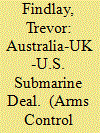| Srl | Item |
| 1 |
ID:
182276


|
|
|
|
|
| Summary/Abstract |
In June 1987, Canada announced that it intended to build 10 to 12 nuclear-powered submarines, based on a French or UK design and fueled with highly enriched uranium (HEU) possibly of Canadian origin. Faced with insurmountable strategic, political, financial, logistical, and nonproliferation obstacles, the idea sank without trace within two years.1 Although the Australian nuclear-powered submarine proposal, announced 34 years later on September 16, is different in several respects, it faces equally strong headwinds that may deliver the same result.
|
|
|
|
|
|
|
|
|
|
|
|
|
|
|
|
| 2 |
ID:
182277


|
|
|
|
|
| Summary/Abstract |
On September 15, U.S. President Joe Biden joined UK Prime Minister Boris Johnson and Australian Prime Minister Scott Morrison to announce an Australian-UK-U.S. security pact (AUKUS) under which the United States and the United Kingdom will assist Australia in building at least eight nuclear-powered attack submarines. The purpose is to strengthen the alliance trying to contain a growing Chinese navy. The first submarine is
not expected to be operational before 2040.
|
|
|
|
|
|
|
|
|
|
|
|
|
|
|
|
| 3 |
ID:
182278


|
|
|
|
|
| Summary/Abstract |
An era of remarkable cooperation between two Cold War adversaries started in 1988 with a controlled detonation of a nuclear device at the Nevada Test Site. Teams of U.S. and Soviet scientists looked on, hoping that the heavy instrumentation they had jointly designed would accurately measure the yield of the explosion in support of verification of the 1974 Threshold Nuclear Test Ban Treaty.1 The exercise, known as the Joint Verification Experiment, was a success. It was also the first concrete manifestation of official laboratory-to-laboratory cooperation on nuclear treaty verification between the two nuclear superpowers.
|
|
|
|
|
|
|
|
|
|
|
|
|
|
|
|
| 4 |
ID:
182275


|
|
|
|
|
| Summary/Abstract |
Twenty-six years ago, as states-parties negotiated the terms for the extension of the nuclear Nonproliferation Treaty (NPT), the future of the treaty was not assured.
|
|
|
|
|
|
|
|
|
|
|
|
|
|
|
|